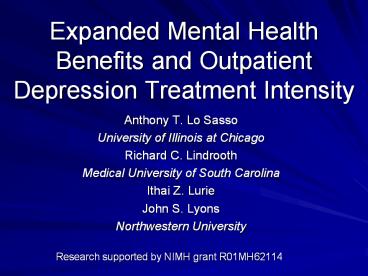Expanded Mental Health Benefits and Outpatient Depression Treatment Intensity PowerPoint PPT Presentation
1 / 17
Title: Expanded Mental Health Benefits and Outpatient Depression Treatment Intensity
1
Expanded Mental Health Benefits and Outpatient
Depression Treatment Intensity
- Anthony T. Lo Sasso
- University of Illinois at Chicago
- Richard C. Lindrooth
- Medical University of South Carolina
- Ithai Z. Lurie
- John S. Lyons
- Northwestern University
- Research supported by NIMH grant R01MH62114
2
Goal of the Research
- To study how a mental health benefit expansion
affected outpatient depression treatment
utilization - Particular emphasis will be placed on examining
how the benefit change affected the dose of
outpatient psycho-therapy received by patients - Initiation ? OP visits ? sufficient of OP visits
3
Setting Benefit Design
- Large Fortune 50 electronics manufacturing
company - Between 1995 and 1996, the company initiated a
new approach in health benefits for mental health
with three components - reduced copayments for mental health treatment
- the creation of a network of select mental health
providers - de-stigmatize the treatment of mental disorders
4
Details on the Benefit Change
- Selective contracting with mental health
providers - High cost sharing utilization limits for
out-of-network care - No limits are placed on in-network mental health
services - Coinsurance rates on inpatient care were changed
from 80 to 90, - 80 coinsurance for outpatient services was
replaced with a flat 10 copayment
5
Data
- Claims and enrollment data from intervention
company for years 1995-1998 - for all persons with a mental health diagnosis or
procedure code suggestive of mental health
treatment - Data only for continuously enrolled members of
the companys self-insured health insurance plan - Comparison group comprised of random sample of
employed persons from Medstat Marketscan
database, 1995-1998
6
Methods
- We compare outpatient treatment in the
intervention group to the comparison group over
time - Outpatient treatment initiation for depression
- Outpatient treatment visits
- An indicator variable for more than 8 visits for
psychotherapy - Basic model
- OP Visits a ßPost ?Intervention
dPostTreatment ?X e
7
Methods II
- By restricting the regression to the
within-provider type impact, we can isolate the
impact of the copayment reduction
destigmatization - OP Visits a' ß'Post ?'Treatment
d'PostTreatment ?1 Non-MD Specialist ?2
MD-Specialist ?'X e - Where d' represents the remaining effect of the
benefit change controlling for the effect of
provider choice
8
Methods III
- Using estimates of the elasticity of demand for
mental health treatment from published studies,
we can decompose d' into the expected impact of
the cost sharing reduction and destigmatization
9
Descriptive Statistics of Depression Treatment
Initiation and Utilization
Intervention Group Intervention Group Intervention Group Control Group Control Group Control Group
Initiation OP visits gt 8 visits Initiation OP visits gt 8 visits
1995 2.2 5.6 28.7 2.5 5.6 21.7
1996 2.6 7.5 41.0 2.3 6.0 25.2
1997 2.7 6.8 38.0 2.0 5.8 27.4
1998 2.7 6.8 37.3 2.1 6.3 26.9
10
Regression Results, Basic Specification
Initiation (Logit-OR) OP Visits (OLS) 8 or More Visits (Logit-OR)
Treatment Post (d) 1.33 1.25 1.25
N310,882 for Initiation regression, n7,560 for
other regressions Indicates 0.01ltplt0.05,
indicates plt0.01
11
Descriptive Statistics of Specialist Use
Percentage gt 8 Visits
Intervention Group Intervention Group Intervention Group Comparison Group Comparison Group Comparison Group
Generalist Non-MD specialist MD Specialist Generalist Non-MD specialist MD Specialist
1995 511 385 143 157 226 171
22.5 35.8 31.5 22.9 21.2 21.1
1996 530 765 150 135 198 132
31.1 46.9 46.5 18.5 27.3 28.8
1997 609 771 124 150 270 142
36.3 39.4 37.9 16.0 34.1 26.8
1998 647 775 83 118 274 117
34.9 39.0 39.8 7.6 37.2 22.2
12
Regression Results, Within-Provider Type
OP Visits (OLS) 8 or More Visits (Logit-OR)
Treatment Post (d') 1.03 1.22
N7,560 Indicates 0.01ltplt0.05, indicates
plt0.01
13
Summary of Findings
- Our prior work has shown that the selective
contracting network was not defined restrictively
enough to increase distance to providers, but the
emphasis on specialist access (particularly
non-MD) had a significant impact on utilization
1.25-1.03 0.23 visits - Based on the RAND HIE elasticity of -0.17, we
calculate the predicted effect of the copayment
reduction to 0.42 visits - The remainder then is attributed to
de-stigmatization 0.6 visits
14
Under Different Assumptions
- If instead we use a higher elasticity measure
from the literature, -0.32, the predicted impact
of the copayment reduction is 0.79 visits - Under this assumption, we are left with a
de-stigmatization effect of 0.23 visits
15
Discussion
- Our empirical results suggest that the
combination of benefit changes instituted by the
company was successful in not only encouraging
more employees to enter depression treatment, but
also in enabling more patients to stay in
treatment longer increasing the likelihood that
they receive the appropriate minimum adequate
dose of 8 outpatient psychotherapy visits
16
Discussion II
- Our results suggest that each aspect of the
benefit changepromotion of in-network specialty
providers, reducing copayments, and a
company-wide effort to reduce the stigma
associated with mental health treatmentplayed an
important part in increasing the number of
outpatient visits per episode of treatment
conditional upon treatment initiation for
depression
17
Conclusion
- Starting treatment is not what matters in
behavioral healthcare - Engaging in a successful episode of care is a far
more relevant indicator - The results point to the potentially important
role that corporate benefit designers and
planners can play in improving access to mental
health care for employees

